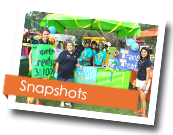

Conflict Resolution and True Colors
One of the great strengths of our Student Affairs team is how we recognize and integrate different perspectives. Still, we can find ourselves in conflict situations -- maybe with other staff, faculty, students or parents. When this happens, the True Colors framework can help.
Below are excerpts from Peaceful Colors – Prevent and Resolve Everyday Conflict Using True Colors by Gail Shapiro1, who effectively unifies Conflict Resolution tools with the True Colors personality assessment concept.
Conflict resolution involves becoming prepared and empowered to peacefully handle conflicts. A skilled conflict resolver must exercise patience, be able to diagnose the cause of the conflict, understand the interests of those involved, motivate oneself and the other participants, be creative, understand consequences and implement a satisfactory resolution.
Conflict resolution offers strategic alternatives to negative behaviors. A goal of conflict resolution is to change negative behavior. At the Harvard Negotiation Project, Roger Fisher and William Ury discussed the fundamentals of negotiation. In their book entitled Getting to Yes: Negotiating Agreement Without Giving In2, they include guidelines for negotiation and provide a well-known model for Conflict Resolution:
- Separate the people from the problem.
- Focus on interests, not positions.
- Generate a variety of possibilities before deciding what to do.
- Insist that the result be based on some objective standard.
The “fundamentals of principled negotiation” mentioned in Getting to Yes are designed to promote collaborative problem solving. They support a non-adversarial way to look at conflict by combining the elements of problem solving, communication and focusing on the individuals’ underlying interests. In this way, both parties in a conflict can “win” by applying these fundamentals of principled negotiation.
The following are some easy ways to remember and implement Conflict Resolution strategies as described in Getting to Yes (models developed by Gail Shapiro2 based upon Principled Negotiation from Getting to Yes):
START resolving
- S – Listen to what the other person is saying or listen to your own instincts.
- T – Take time to calm down.
- A – Always have a positive attitude.
- R – Use all of your resources to resolve the conflict and feel comfortable again.
- T – Think first.
STOP fighting
- S – Listen to what the other person is saying.
- T – Take time to cool off before reacting.
- O – Make a list and pick the peaceful options that can resolve the conflict.
- P – Deal with the problem and take the emotions out of the equation.
Communication skills are essential to conflict resolution and conflict resolution skills must be practiced to become effective. The combination of Conflict Resolution and True Colors strengthens bonds and connections between people by enabling them to easily understand various points of view and teaches them to resolve differences peacefully. Because these values, needs, attitudes and behaviors can be explained, then personality trait theory or personality assessment should be the foundation for any method of preventing and resolving conflicts. Uniting Conflict Resolution tools with the True Colors personality assessment concept creates a highly effective strategy that can enable anyone to lead a more peaceful life.
Sources
1Gail Shapiro, Peaceful Colors – Prevent and Resolve Everyday Conflict Using True Colors (based on Don Lowry’s True Colors).
2Roger Fisher and William Ury, Getting to Yes: Negotiating Agreement Without Giving In.
Submitted by,
Carol Gonzalez
Student Ombudsperson,
Office of the Vice President for Student Affairs
Has your color spectrum changed over the years? How?
Describe those changes to your colleagues. Remember True Colors is a tool to understanding others and ourselves. It is a common language because we talk about it and use it to articulate our perspectives to each other. Keep it going.

Training Schedule for Student Affairs STAFF (SD 410) — Spring 2015 (Download PDF)
Training Schedule for Student Affairs STUDENT WORKERS (SD 417) — Spring 2015 (Download PDF)
Any questions or comments? Please send us an email at VPSA@utsa.edu.













